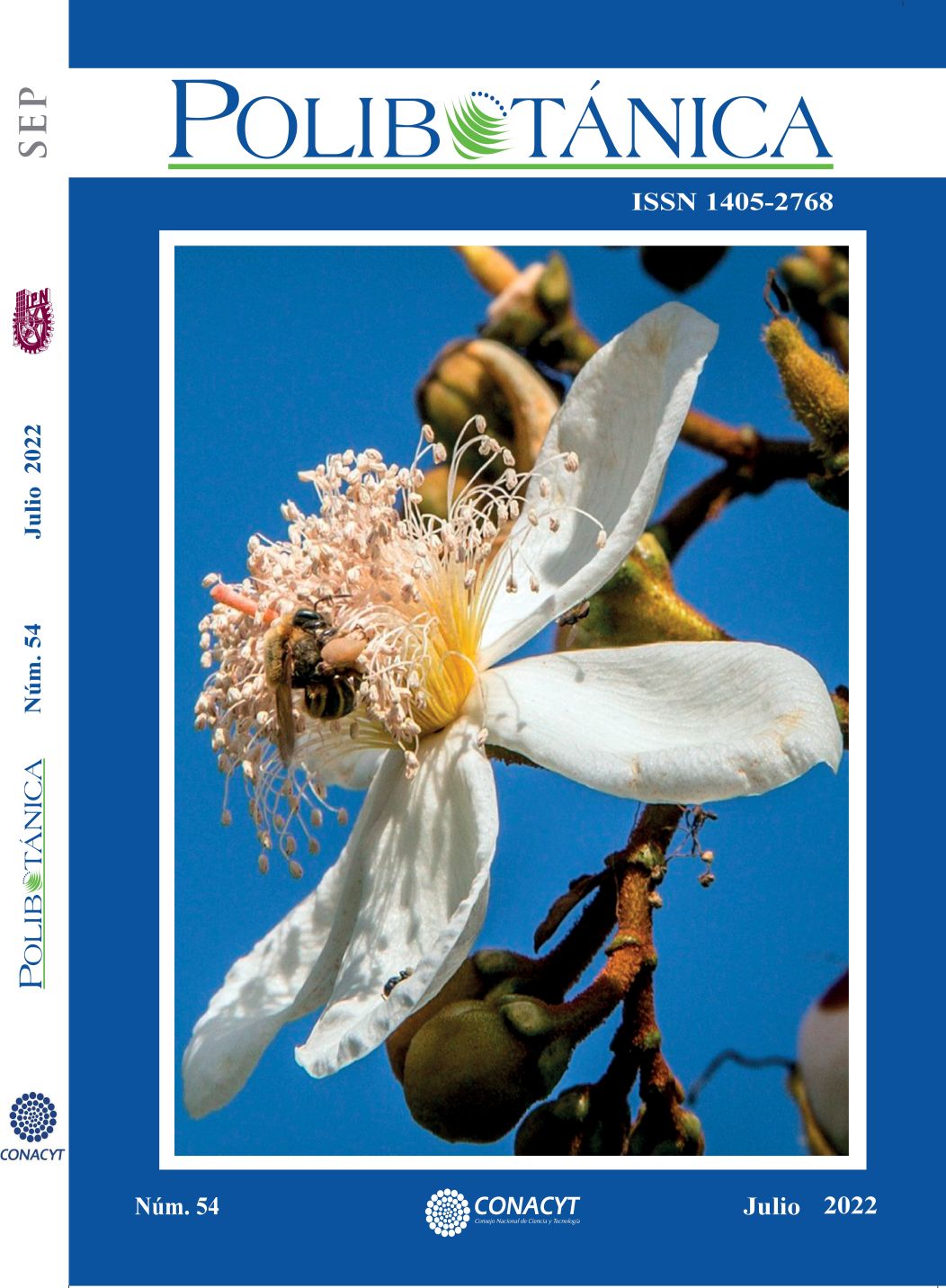Evaluación de una restauración mediante dron en el matorral espinoso tamaulipeco
DOI:
https://doi.org/10.18387/polibotanica.54.5Palabras clave:
dron, NDVI, RPAS, sobrevivencia, vigorResumen
La evaluación de los proyectos de restauración forestal es importante y suele ser a largo plazo con evaluaciones intermedias. Para disminuir los tiempos de evaluación en campo una alternativa es el uso de la teledetección mediante vehículos aéreos no tripulados (VANT). El objetivo fue probar la utilidad de un sistema transportado por vehículos aéreos no tripulados para el monitoreo espacial de una plantación forestal. Se realizó la evaluación en campo de sobrevivencia y estado de vigor de cada una de las plantas, registrando la ubicación, especie, sobrevivencia (V = vivo, M = muerto) y vigor de la planta (B = bueno, R = regular y M = muerta), además se realizó un vuelo conformado por el UAS/RPAS, marca Wingtra, con una cámara multiespectral Micasense® Altum® de 6 sensores de nueva generación (azul, verde, rojo, borde rojo e infrarrojo cercano y térmico), de esa información de calculó NDVI y se extrajeron los valores según un búfer de 30 cm. Se determinó que los valores promedio del NDVI para plantas muertas fue menor a 0.35 y las plantas vivas mayor a 0.35, donde se obtuvo un 57.72 % de precisión global. Para el vigor, se determinó que para el estado muerta el valor promedio del NDVI fueron menores a 0.35, el estado regular fue en el rango de 0.35 a 0.38 y, por último, el estado bueno el rango de NDVI fue mayor a 0.38, con una precisión global de 43.79 %. Se concluye que, el sistema transportado por vehículos aéreos no tripulados (VANT) tiene potencial de ser usado para evaluar plantaciones forestales de especies mixtas del matorral espinoso tamaulipeco.
Referencias
Almeida, D. R. A., Broadbent, E. N., Zambrano, A. M. A., Wilkinson, B. E., Ferreira, M. E., Chazdon, R., … Brancalion, P. H. S. (2019). Monitoring the structure of forest restoration plantations with a drone-lidar system. International Journal of Applied Earth Observation and Geoinformation, 79(March), 192–198. https://doi.org/10.1016/j.jag.2019.03.014
Anderson, K., & Gaston, K. J. (2013). Lightweight unmanned aerial vehicles will revolutionize spatial ecology. Frontiers in Ecology and the Environment, 11(3), 138–146. https://doi.org/10.1890/120150
Barbati, A., Corona, P., & Marchetti, M. (2007). A forest typology for monitoring sustainable forest management: The case of European Forest Types. Plant Biosystems, 141(1), 93–103. https://doi.org/10.1080/11263500601153842
Chemura, A., Mutanga, O., & Dube, T. (2017). Integrating age in the detection and mapping of incongruous patches in coffee (Coffea arabica) plantations using multi-temporal Landsat 8 NDVI anomalies. International Journal of Applied Earth Observation and Geoinformation, 57, 1–13. https://doi.org/10.1016/j.jag.2016.12.007
Chuvieco, E. (1996). Fundamentos de Teledetección Espacial (Tercera ed). Madrid, España: RIAL.
Doi, R. (2020). Assessing the reforestation effects of plantation plots in the Thai savanna based on 45 cm resolution true-color images and machine learning. Environmental Research Letters, 16(1). https://doi.org/10.1088/1748-9326/abcfe3
Estrada Zúñiga, A. C., & Vásquez, J. Ñ. (2021). Detection and identification of high Andean plant communities, Wetlands and Tolar de Puna Seca by means of RGB and NDVI orthophotos in “Unmanned Aerial Systems” drones. Scientia Agropecuaria, 12(3), 291–301. https://doi.org/10.17268/SCI.AGROPECU.2021.032
García, E. (2004). Modificaciones al sistema de clasificación climática de Köppen (Quinta Edi). México D. F.: Instituto de Geografia - UNAM. Retrieved from http://www.igeograf.unam.mx/sigg/utilidades/docs/pdfs/publicaciones/geo_siglo21/serie_lib/modific_al_sis.pdf
Goodbody, T. R. H., Coops, N. C., Marshall, P. L., Tompalski, P., & Crawford, P. (2017). Unmanned aerial systems for precision forest inventory purposes: A review and case study. Forestry Chronicle, 93(1), 71–81. https://doi.org/10.5558/tfc2017-012
Hernández Ramos, A., Cano Pineda, A., Buendía Rodríguez, E., Tamarit Urias, J. C., & Hernández Ramos, J. (2020). Mapeo del peso verde y cobertura arbistiva de Euphorbia antisyphilitica Zucc. con datos espectrales del satelite Sentinel-2. In I. Orona Castillo, A. Amador Machado, J. Puentes Gutiérrez, M. Fortis Hernández, P. Preciado Rangel, & F. J. Ruiz Ortega (Eds.), Memoria de la XXXII Semana Internacional de Agronomía (1ra ed., pp. 1254–1260). Venecia, Durango, México: Universidad Juárez del Estado de Durango, Facultad de Agricultura y Zootecnia.
Katila, P., Colfer, C. J. P., de Jong, W., Galloway, G., Pacheco, P., & Winkel, G. (2019). Sustainable development goals: Their impacts on forests and people. Sustainable Development Goals: Their Impacts on Forests and People, 1–617. https://doi.org/10.1017/9781108765015
Pequeño-Ledezma, M., Alanís-Rodríguez, E., Jiménez-Pérez, J., Aguirre-Calderón, O., González-Tagle, M. A., & Molina Guerra, V. M. (2016). Criterios a considerar para desarrollar proyectos de restauración ecológica. Revista Iberoamericana de Ciencias, 3(2), 94–105. Retrieved from http://reibci.org/publicados/2016/jun/1600108.pdf
Plaza Duarte, H. (2020). Niveles de vigorosidad de plantaciones de teca, (Tectona grandis), mediante índices de vegetación. Universidad Técnica Estatal de Quevedo. Retrieved from https://repositorio.uteq.edu.ec/handle/43000/6288
Reed B., C., Schwartz M., D., & Xiao, X. (2009). Remote sensing phenology: Status and the way forward. In A. Noormets (Ed.), Phenology of ecosystem processes (pp. 231–246). Netherlands: Springer. https://doi.org/10.1007/9781-4419-0026-5_10
van Leeuwen, M., & Nieuwenhuis, M. (2010). Retrieval of forest structural parameters using LiDAR remote sensing. European Journal of Forest Research, 129(4), 749–770. https://doi.org/10.1007/s10342-010-0381-4
Wang, Q., Tenhunen, J., Dinh, N. Q., Reichstein, M., Vesala, T., & Keronen, P. (2004). Similarities in ground- and satellite-based NDVI time series and their relationship to physiological activity of a Scots pine forest in Finland. Remote Sensing of Environment, 93(1–2), 225–237. https://doi.org/10.1016/j.rse.2004.07.006
White, R. A., Bomber, M., Hupy, J. P., & Shortridge, A. (2018). UAS-GEOBIA approach to sapling identification in jack pine barrens after fire. Drones, 2(4), 1–15. https://doi.org/10.3390/drones2040040
Zar, J. H. (2010). Biostatistical analysis (5th ed.). New Jersey: Prentice Hall.
Descargas
Publicado
Número
Sección
Licencia

Polibotánica por Departamento de Botánica de la Escuela Nacional de Ciencias Biológicas del Instituto Politécnico Nacional se distribuye bajo una Licencia Creative Commons Atribución-NoComercial-CompartirIgual 4.0 Internacional.




















